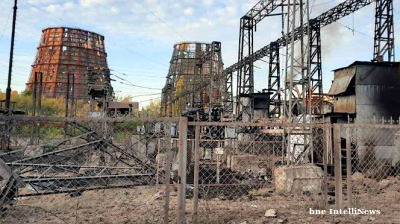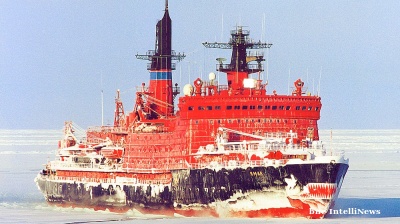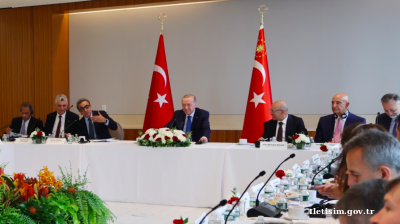The impact of the sanctions on Russia have been milder than expected and the record high current account surpluses have cushioned the blow. However, the sanctions will have a heavy toll on Russia’s economic performance going forward with a sharp contraction this year and less than 2% growth per year predicted for the next three years, the Central Bank of Russia (CBR) reported in its macroeconomic survey in June.
GDP fell 4.3% year on year in May, according to the Ministry of Economy, down from a 2.8% fall in April (chart). However, this was less than economists were expecting, who have started to improve their outlooks for the full year from the 15% contraction many predicted shortly after the fighting started to around a 10% contraction.
The CBR has also improved its prediction for growth this year from a 8% contraction by year end to a revised 6.1% contraction, according to its June macroeconomic survey (graphic). GDP will then recover to a 1.3% contraction in 2023 before
The improved forecast comes on the back of improvements in other indicators.
An upbeat data release by the Russian statistics agency RosStat in June suggests that Russia's economy is doing better than expected. The latest PMI indices also returned to the black in June, as the effects of the sanctions started to wear off.
 The CBR is also predicting an improvement to most of the other indicators, although none of them escape the negative effects of sanctions.
The CBR is also predicting an improvement to most of the other indicators, although none of them escape the negative effects of sanctions.
The CBR is forecasting that inflation will hit 15% this year and indeed is already falling from its 17.8% peak in April to 15.9% in June (chart). With fears of stagflation running high and inflation soaring around the world, Russia is currently the only country in Europe where inflation has passed peak and has begun to fall. In Ukraine, in particular, the National Bank of Ukraine (NBU) reported on July 14 that inflation jumped again to 21.5% in June (chart), despite a massive interest rate hike to 25% on June 2 (chart).
As inflationary pressures start to fade the CBR has already made four rate cuts in three months (chart) and brought the prime rate back to the pre-war level of 9.5% on June 10 and is expected to make more cuts in the coming months. The CBR is predicting Russia will finish this year with the key rate at 7.5% in 2023 before cutting again to 6.5% and then 6% in the next two years.
Unemployment is expected to rise as a result of the sanctions, but so far it has fallen to a new post-Soviet low of 3.9% in June (chart) and the CBR is predicting it will remain at modest levels of between 5% and 5.5% in the next two years before falling to 4.5% in 2025. Likewise, real wages will decline this year as the nominal wage increase is expected to be only 10% this year, when inflation will be 15% in the same year, delivering a real reduction in income of 5%. However, the balance will reverse next year, according to the CBR, with nominal wage increases up by 7% while inflation drops to 6.1%, leading to a modest growth in real incomes of 0.9%. That will improve over the next two years to a 2% growth in real incomes by 2025, says the CBR.
The CBR also predicts that Russia will maintain a positive balance of payments throughout the next three years, earning a surplus of around $70bn a year, down from the current all-time highs where Russia has been earning that much a month. As a result of the reduction in trade the ruble will weaken over the next few years to end 2022 at RUB70.4 to the dollar before weakening further over the next three years to end 2025 at RUB80 to the dollar.
Much remains uncertain in all these predictions. Europe faces an energy crisis this winter, but it is also working on a seventh package of sanctions that include an oil price cap mechanism that could dramatically affect Russia’s export revenues if it can be enforced.
Another big unknown is the accelerating stagflation crisis that could trigger a global recession that could last several years if central banks fail to rise to the challenge of pursuing a much tougher tightening policy.
Below is reproduced the CBR’s comments on the results of its survey of analysts on main indicators, as well as its charts that display the spread of its confidence in its predictions:
Inflation (chart): In the July survey, the median forecast for 2022 decreased by 2 pp to 15.0%, for 2023 – decreased by 0.6 pp to 6.1%. Expectations for 2024 decreased by 0.8 pp to 4.2%. Analysts expect inflation to remain near 4% in 2025 as well.

Key rate (chart): The median forecast of the average key rate remained virtually unchanged (11% per annum). In 2023, it decreased by 0.5 pp to 7.5%, in 2024 by 0.5 pp to 6.5%, and in 2025 by 0.3 pp to 6.0% per annum. The estimate of the neutral key rate remained at the same level of 6.5% per annum.

GDP (chart): Analysts improved their 2022 GDP forecast from −7.5% to −6.0%. At the same time, analysts worsened the forecast for 2023 from 0.0% to −1.3% and for 2024 from 1.8% to 1.5%. Thus the real GDP level forecast for 2024 is almost unchanged. The forecast for 2025 and estimates of long-term GDP growth also remained unchanged at 1.8% and 1.5% respectively.

Unemployment rate (chart): Analysts lowered the unemployment forecast by 0.9 pp to 5.6% at the end of 2022, by 0.4 pp to 5.5% at the end of 2023, and by 0.4 pp to 4.5% at the end of 2025. The forecast for 2024 remained unchanged at 5.0%.

Nominal Wages (chart): Analysts kept unchanged the growth forecast for 2022 and 2023 (10.0% and 7.0% respectively). The forecast for 2024 and 2025 was lowered by 0.3 pp to 6.4% and by 0.2 pp to 6.0%.

Exports of goods and services (chart): Compared to the June survey, the forecast for exports is higher, especially for 2022-2023. Analysts expect the value of exports to be $520bn in 2022 and further from $439bn to $452bn in 2023 to 2025.

Imports of goods and services (chart): Imports forecast raised by $20bn to $32bn over the forecast horizon. Analysts project a decline in the value of imports from $379bn in 2021 to $300bn in 2022. It is expected to consistently recover to $322bn, $340bn, $370bn in 2023-2025 respectively.

USD/RUB exchange rate (chart): In general, analysts expect a stronger ruble over the entire forecast horizon compared to the June survey, but with a gradual weakening trend, similar to the June forecast. In 2022, the exchange rate is expected to average RUB70.4 per dollar per year, in 2023, RUB75.0, and in 2024-2025, RUB80.0.

The ranges of analysts’ forecasts have mostly continued to narrow, but remain wide, especially for 2022 (see shaded areas in the charts). For exports, imports, and exchange rates, the ranges are just as wide for 2023 to the end of 2024.
Features

Ambition, access and acceleration – Uzbekistan’s Startup Garage opens free academy for entrepreneurship
Aim is to train 50,000 young founders by 2030.

Ukraine’s growing energy crisis promises a cold and dark winter
Since the summer, Kyiv has changed tactics. Given the almost complete failure of Western oil sanctions to curb Russian oil exports, it has been targeting Russian oil refineries. The Kremlin has struck back, targeting Ukraine's power system.

Russia, China sign off on Northern Route shipping deal to slash global freight times
Russia and China have signed a landmark agreement to develop and commercialise the Northern Sea Route (NSR), after Beijing tested the route last month, that could slash Europe-Asia cargo transit times and challenge the primacy of the Suez Canal.

Sri Lanka’s economic escape
Sri Lanka’s recovery over the past year reads like a narrow escape rendered into a cautious, albeit unfinished success story.



